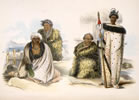There were many traditional composers, whose art can be seen within their compositions.
Mananui Te Heuheu
Mananui Te Heuheu was the son of Te Heuheu Herea and paramount chief of Ngāti Tūwharetoa of Taupō. He composed a waiata tangi (lament) for his younger brother, Pāpaka Te Naeroa, who died in a battle near Ōtaki. This song, ‘Taku tirotiro noa’ (I look about in vain), is one of the great masterworks of the mōteatea tradition. In his grief, Te Heuheu berates his younger brother for being impulsive and impetuous and asks about his transgressions.
Haere rā e Pā!
I ngā tai whakarewa kauri ki te uru.
Tūtanga pō noa e roto i ahau;
Kei te aha tō hara?
Kei ngā ara tahataha nunui a Tiki-māeroero
Kei te aha tō hara?
Kei ngā tūranga rau a te toa.
Kei ō hīanga i tukua iho ai,
Ka moe koe i te kino; te hoa ē ī!
Farewell, O Sir!
Depart with the kauri-bearing tides of the western sea.
Distracted thoughts abide with me in the night;
Where was your transgression?
Perchance, ’twas on the steep trails of Tiki-the-heedless.
Where was your transgression?
Perchance, ’twas in the crowded pathway of the brave
With your unruly spirit leading you on,
Thus to fall asleep in death; my comrade, alas!1
Te Rangitopeora
Te Rangitopeora was born at Kāwhia early in the 19th century. Her mother was Waitohi of Ngāti Toa and Ngāti Raukawa, and her father was Te Rā-ka-herea of Ngāti Toarangatira. Her hapū were Ngāti Kimihia and Ngāti Te Maunu.
Te Rangitopeora was a well-known woman of stature, taking the name Kuini Wikitōria (Queen Victoria) when she was baptised in Ōtaki in 1847. Te Rangitopeora was one of five women who signed the Treaty of Waitangi, and was a niece of Te Rauparaha, the great Ngāti Toa chief. Te Rangitopeora was romantically connected with many men, a topic on which she composed numerous songs. At one point, she fell in love with a Waikato man called Riripō who was already married. She wrote the following waiata to him.
Rangi kōrerehu i marewa atu ai,
Tahuri mai hoki kōrua ko tō kanohi.
Wai hoki te mea ka riua ia rā ki tō wahine;
Taea te hōmai hei whakaara i taku moe.
’Twas a misty-dismal day when you departed,
You gave one backward glance and I saw your face,
Nought now avails for you are gone to your spouse;
All that remains gives me wakeful nights.2
Mihi-ki-te-kapua
Mihi-ki-te-kapua was a renowned and prolific Ngāti Ruapani and Ngāi Tūhoe composer who lived in the 19th century. Her best-known composition is a lament for her husband, Hikawai, ‘Taku rākau e’, which is commonly sung by Tūhoe people in the 2000s. The following extract is from another waiata about her feelings of loneliness.
Engari te tītī e tangi haere ana, e,
Whai tokorua rawa rāua;
Tēnā ko au nei, e manu e,
Kei te hua kiwi i mahue i te tawai;
Fortunate the tītī [muttonbird], as it cries in flight,
It has the company of its mate;
As for me, my bird, I am like,
The egg, abandoned by the kiwi at the tawai roots.3







